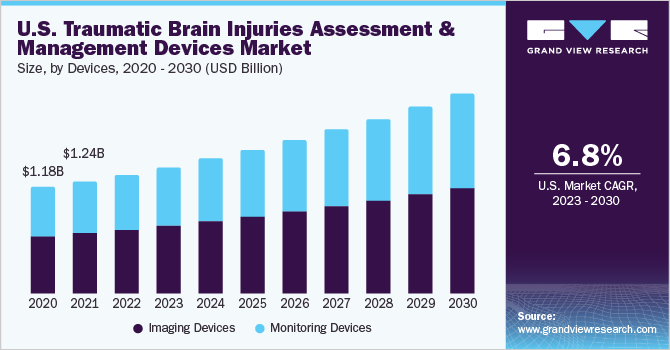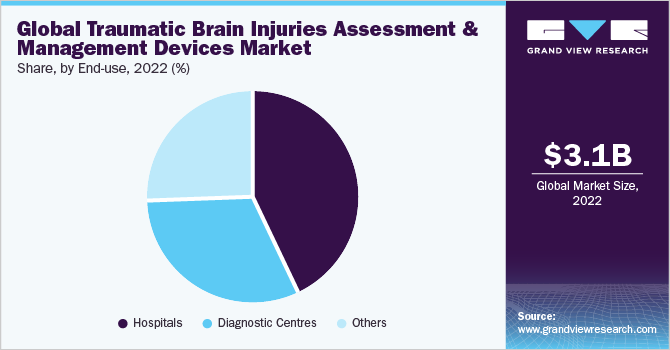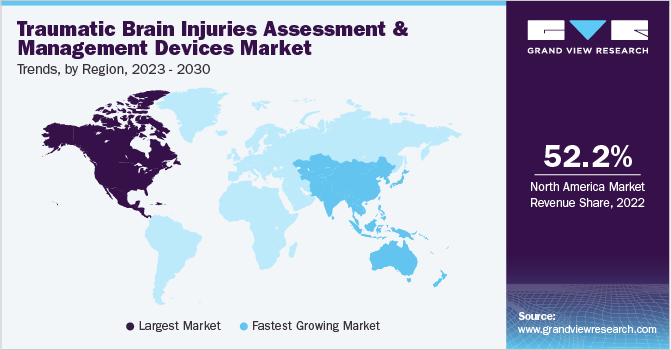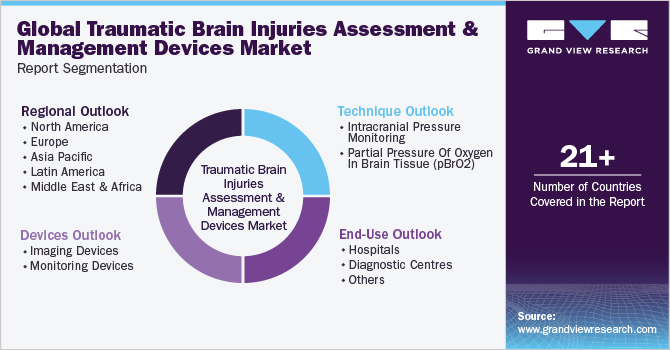- Home
- »
- Medical Devices
- »
-
Traumatic Brain Injuries Assessment And Management Devices Market Report 2030GVR Report cover
![Traumatic Brain Injuries Assessment And Management Devices Market Size, Share & Trends Report]()
Traumatic Brain Injuries Assessment And Management Devices Market Size, Share & Trends Analysis Report By Devices (Imaging Devices, Monitoring Devices), By Technique, By End Use (Diagnostic Centers), By Region, And Segment Forecasts, 2023 - 2030
- Report ID: GVR-4-68038-495-6
- Number of Report Pages: 152
- Format: PDF, Horizon Databook
- Historical Range: 2018 - 2021
- Forecast Period: 2023 - 2030
- Industry: Healthcare
Report Overview
The global traumatic brain injuries assessment and management devices market size was valued at USD 3.09 billion in 2022 and is expected to grow at a compound annual growth rate (CAGR) of 7.6% from 2023 to 2030. The increasing prevalence of traumatic brain injuries (TBIs), rising patients’ preference for minimally invasive procedures, as well as raising awareness regarding brain injury treatment are the major factors expected to drive the market. In addition, the adoption of technologically advanced products, and supportive government policies are a few more factors contributing to the market growth. For instance, the Medical Research Future Fund (MRFF) announced an investment of USD 50 million under the 2019-2020 budget for the traumatic brain injury mission initiated by the Australian government. The aim of the investment was to enhance patient recovery from brain injury.

Major causes of TBIs include sports injuries, falls, gunshot wounds, domestic violence, and road traffic accidents. As per the Center for Disease Control and Prevention (CDC), in the U.S., nearly 69,000 TBI-related deaths occurred in 2021 i.e., around 190 TBI-related fatalities daily. Furthermore, according to Stanford Children’s Health, over 3.5 million sports-related injuries are reported annually among children in the U.S. and around 21% of all are TBIs. Thus, increasing cases of TBIs due to sports injuries, road accidents, and assaults are anticipated to boost the market growth during the forecast period.
The rising demand for minimally invasive neuro procedures owing to less pain and chances of infection along with speedy recovery is expected to boost the demand for TBIs assessment and management devices. Furthermore, an increasing number of initiatives and programs being undertaken by the governments of various countries about brain injuries are expected to fuel the market growth. For instance, the Brain Injury Association of America (BIAA) as an initiative toward traumatic brain injuries organizes a national public awareness campaign in March every year to emphasize the importance of acknowledging the impact of brain injuries.
The campaign ‘Change Your Mind’ from 2018 to 2020 educates the public about the occurrence of brain injury and the needs of people with brain injuries and their families. Similarly, Defense and Veterans Brain Injury Center (DVBIC) offers online education for both civilian and military providers to learn about traumatic brain injury to promote the best possible care for service members and veterans around the world. Thus, growing awareness among people regarding the treatment to prevent the rate of TBIs is likely to boost the market growth. Countries, such as the U.S. and Canada, have witnessed a high prevalence rate of TBIs due to road accidents, sports injuries, and assaults.
Gunshots or explosive blast exposure are a common cause of TBIs in active-duty military personnel. For instance, as per the Defense and Veterans Brain Injury Center (DVBIC), between 2000 and late 2019 around 414,000 TBIs have been reported among U.S. military members. According to the Brain Injury Association Waterloo-Wellington, over 11,000 individuals die due to TBIs every year in Canada, and over 6,000 become permanently disabled post-TBIs. Therefore, such a high prevalence rate of TBIs is estimated to boost the market growth over the forecast period.
The outbreak of COVID-19 in the year 2020 had a short-term and moderate impact on the market by directly affecting the demand & production, creating a disruption in the supply chain, and increasing the financial burden on firms. To reduce the spread of the coronavirus, brain surgeries have frequently been postponed or even canceled during this timeframe. In worst-affected nations, such as the U.S., Russia, India, Brazil, France, the U.K., Italy, and Spain, neurosurgical operations fell by 55%. However, according to a study published in the Elsevier journal (International Hemorrhagic Hospital Association) (Jan 2021) titled “COVID-19 and Hospital: A review”, up to 36% of hospitalized COVID-19 patients may experience neurological symptoms, and there have been several cases of ischemic and hemorrhagic infarction. Another recent research study published in Neurology Online Journal proposes that the COVID-19 virus might be responsible for patients acquiring novel neurological diseases.
Devices Insights
Based on devices, the market has been segmented into imaging devices and monitoring devices. The imaging devices segment held the largest market share of 53.8% in 2022. The imaging devices segment is further sub-categorized into Computed Tomography (CT) scan, Magnetic Resonance Imaging (MRI) devices, X-ray, and others. Due to higher sensitivity, imaging devices are widely used to assess patients with mild or severe TBI. Thus, increasing application scope in the diagnosis and staging of neurological diseases & disorders, particularly TBIs, is expected to drive the segment. In March 2022, Swift Medical Inc. introduced the Swift Ray 1, an innovative hardware device that can be wirelessly connected to a smartphone camera. This device revolutionizes the field of wound care technology by capturing comprehensive clinical data, which greatly enhances the assessment, monitoring treatment of wound and other skin conditions. The Swift Ray 1 is designed to be compact, easily fitting in the palm of a clinician or patient's hand, allowing for convenient and portable medical imaging. This groundbreaking technology empowers healthcare professionals to access powerful imaging capabilities anywhere, from the hospital setting to the comfort of a patient's home. The monitoring devices segment is expected to register the fastest CAGR growth of 7.9% over the forecast period 2023-2020. This can be attributed to the minimally invasive nature of these devices and increasing awareness and improvements in healthcare facilities. In addition, factors, such as greater accuracy of these devices, increasing patient preference for non-invasive procedures, and a high preference among physicians for brain disease progression monitoring, are expected to drive the growth of this segment during the forecast period.
Technique Insights
Based on techniques, the market has been segmented into intracranial pressure monitoring and partial pressure of oxygen in brain tissue (pBrO2). The intracranial pressure monitoring segment dominated the market with a revenue share of 54.3% in 2022. This method is considered a gold standard for the measurement of accurate increased intracranial pressure in patients with severe brain injury. Several studies have recommended that raised intracranial pressure is the common cause of death in patients with TBI. Therefore, continuous intracranial pressure monitoring helps in keeping the pressure levels in a normal range and provides early and effective treatment. Thus, the advantages offered by intracranial pressure monitoring and an increasing number of TBI patients are expected to boost the market growth.
The partial pressure of oxygen in the brain tissue (pBrO2) segment is expected to grow at the fastest CAGR of 8.0% from 2023 to 2030. Continuous pBrO2 monitoring provides timely information about cerebral oxygen demand in patients suffering from TBI. The pBrO2 monitoring systems provide continuous monitoring of partial pressure of oxygen in brain tissue, thus providing an early indication of hypoxic events. These factors are anticipated to boost the segment growth during the forecast period.
End-Use Insights
Based on end-use, the market has been segmented into hospitals, diagnostic centers, and others. The hospital segment dominated the market in 2022 and accounted for the maximum share of 42.8% of the overall revenue. This growth was mainly attributed to a rise in the number of brain surgeries performed in hospitals as well as an increase in the prevalence of TBI patients across the globe. In addition, hospitals are well equipped with technologically advanced devices that are used by professional neurologists, which is expected to boost the segment growth over the forecast period.

The other segment, which includes Ambulatory Surgical Centers (ASCs), research centers, and emergency clinics is expected to register the fastest CAGR of 8.0% from 2023 to 2030. This growth can be attributed to various advantages offered by emergency clinics and ASCs, such as shorter procedure time and same-day discharge, over hospitals. Furthermore, most brain surgeries can now be performed at ASCs, as these procedures turn out to be more advanced and less invasive. Thus, the growth of the other segment is majorly attributed to inexpensive and ongoing advancements in minimally invasive surgical techniques as well as shorter procedure times.
Regional Insights
North America dominated the market with a share of more than 52.2% in 2022. This is attributed to the presence of well-established healthcare facilities in the region, increasing government initiatives, awareness campaigns regarding brain injuries, and greater incidence of TBIs in the continent. For instance, as per the CDC, an expected 2.87 million individuals in the U.S. sustain brain injuries and 1.5 million Americans sustain a TBI annually. In the U.S, in 2021 more than 5.3 million people have a permanent TBI-related disability. These incidence rates involve around 2.5 million TBI-related emergency department visits, 288,000 hospitalizations, and 56,800 deaths. Thus, contributing to the market growth in the region.

Asia Pacific is expected to grow at the highest CAGR of 9.1% from 2023 to 2030. This is due to factors, such as growth in the aging population, a rise in the number of people suffering from TBIs, an increasing incidence of road accidents, and violence. For instance, according to the Ministry of Road Transport and Highways, Government of India, a total of 4,12,432 road accidents in 2021 caused injuries to 3,84,448 persons. In addition, growing patient affordability has resulted in a significant number of interventional procedures in the Asia Pacific region.
Competitive Insights
The market is highly competitive, with a large number of manufacturers accounting for a majority of the market share. Product launches, approvals, strategic acquisitions, research & development, and innovations are just a few of the important business strategies adopted by market participants to maintain and grow their global reach. For instance, in October 2021, scientists at the University of Alabama at Birmingham (UAB) in the U.S. initiated the evaluation of a new non-invasion technique. The U.S. Food and Drug Administration (FDA) approved the technique to measure hematoma expansion in the brain. The UAB team planned to launch a device called Infrascanner for monitoring brain injury. The following are some of the major participants in the TBI assessment and management devices market:
-
Integra Lifesciences
-
BioDirection, Inc.
-
Nihon Kohden Corp.
-
Compumedics Ltd.
-
InfraScan, Inc.
-
Oculogica
-
Raumedic AG
Traumatic Brain Injuries Assessment And Management Devices Market Report Scope
Report Attribute
Details
Market size value in 2023
USD 3.31 billion
Revenue forecast in 2030
USD 5.53 billion
Growth rate
CAGR of 7.6% from 2023 to 2030
Base year for estimation
2022
Historical data
2018 - 2021
Forecast period
2023 - 2030
Report updated
September 2023
Quantitative units
Revenue in USD million/billion and CAGR from 2023 to 2030
Report coverage
Revenue forecast, company ranking, competitive landscape, growth factors, and trends
Segments covered
Devices, technique, end-use, region
Regional scope
North America; Europe; Asia Pacific; Latin America; and MEA
Country scope
U.S.; Canada; U.K.; Germany; France; Italy; Spain; Denmark; Sweden; Norway; China; Japan; India; Australia; South Korea; Thailand; Brazil; Mexico; Argentina; Saudi Arabia; South Africa; UAE; Kuwait
Key companies profiled
Integra Lifesciences; BioDirection, Inc.; Nihon Kohden Corp.; Compumedics Ltd.; InfraScan, Inc.; Oculogica; Raumedic AG
Customization scope
Free report customization (equivalent up to 8 analyst’s working days) with purchase. Addition or alteration to country, regional & segment scope
Pricing and purchase options
Avail customized purchase options to meet your exact research needs. Explore purchase options
Global Traumatic Brain Injuries Assessment And Management Devices Market Report Segmentation
This report forecasts revenue growth at global, regional, and country levels and provides an analysis of the latest industry trends in each of the sub-segments from 2018 to 2030. For this study, Grand View Research has segmented the global traumatic brain injuries assessment and management devices market based on devices, technique, end-use, and region:

-
Devices Outlook (Revenue in USD Million, 2018 - 2030)
-
Imaging Devices
-
Magnetic Resonance Imaging (MRI) Devices
-
X-Ray
-
Computed Tomography
-
-
Monitoring Devices
-
-
Technique Outlook (Revenue in USD Million, 2018 - 2030)
-
Intracranial Pressure Monitoring
-
Partial Pressure Of Oxygen In Brain Tissue (pBrO2)
-
-
End-Use Outlook (Revenue in USD Million, 2018 - 2030)
-
Hospitals
-
Diagnostic centres
-
Others
-
-
Regional Outlook (Revenue in USD Million, 2018 - 2030)
-
North America
-
U.S.
-
Canada
-
-
Europe
-
UK
-
Germany
-
France
-
Italy
-
Spain
-
Sweden
-
Norway
-
Denmark
-
-
Asia Pacific
-
China
-
Japan
-
India
-
Australia
-
Thailand
-
South Korea
-
-
Latin America
-
Brazil
-
Mexico
-
Argentina
-
-
Middle East and Africa
-
Saudi Arabia
-
South Africa
-
UAE
-
Kuwait
-
-
Frequently Asked Questions About This Report
b. The global traumatic brain injury assessment and management devices market size was estimated at USD 3.09 billion in 2022 and is expected to reach USD 3.31 billion in 2023.
b. The global traumatic brain injury assessment and management devices market is expected to grow at a compound annual growth rate of 7.6% from 2023 to 2030 to reach USD 5.53 billion by 2030.
b. North America dominated the traumatic brain injury assessment and management devices market with a share of 52.2% in 2022. This is attributable to the increasing incidence of Traumatic Brain Injuries (TBIs), increasing awareness campaigns regarding brain injuries, and the presence of well -established healthcare facilities.
b. Some of the key players operating in the traumatic brain injury assessment and management devices market include BioDirection, Inc., BrainScope Company, Inc., Neural Analytics, Inc., Compumedics Ltd., Advanced Brain Monitoring Inc, Natus Medical, Inc.
b. Key factors that are driving the traumatic brain injury assessment and management devices market growth include the growing incidence of TBIs due to increasing sports injuries and road accidents, increasing demand for non-invasive devices for the assessment of Traumatic Brain Injuries (TBIs), and raising awareness about Traumatic Brain Injuries (TBIs).
Share this report with your colleague or friend.
![gvr icn]()
NEED A CUSTOM REPORT?
We can customize every report - free of charge - including purchasing stand-alone sections or country-level reports, as well as offer affordable discounts for start-ups & universities. Contact us now
![Certified Icon]()
We are GDPR and CCPA compliant! Your transaction & personal information is safe and secure. For more details, please read our privacy policy.
We are committed towards customer satisfaction, and quality service.
"The quality of research they have done for us has been excellent."





